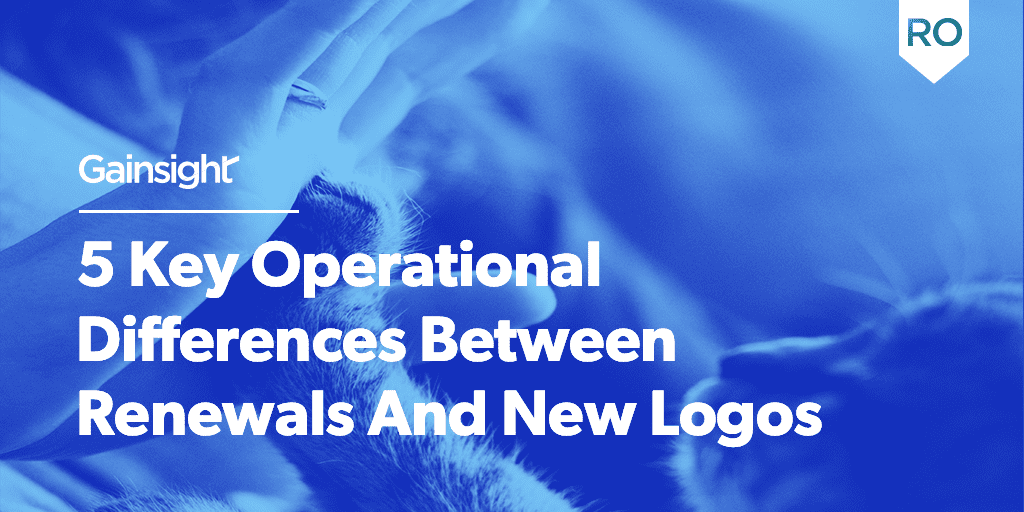This post was co-authored by Kelly Dehart.
Revenue leaders who own both renewals as well as new business recognize that managing renewals is a completely different beast.
From forecasting to managing KPIs, the renewals motion requires a fundamentally different approach. But what exactly makes managing a renewals business unique? We outline five key differences:
1. You Have Access to Rich Customer Data That Enables Better Forecasting…
When it comes to forecasting a renewals business, you have a secret weapon that you don’t have when hunting for new business: the ability to mine and analyze rich historical customer data to figure out what’s likely to happen next.
You have probably been (or otherwise you should be!) collecting data on cohorts of your customers over time, meaning insights about their usage, sentiment, engagement, support tickets and—most importantly—whether they have renewed, churned, or downsold. Perhaps customers who have usage that looks a certain way have pretty much always renewed, or ones that have poor sentiment and engagement from specific stakeholders are at greater risk of churn. If you’re not using these kinds of analytics to inform your forecast for renewals, you’re probably leaving money on the table.
2. …Which Can Also Reveal Strong Upsell Candidates
In addition to helping you develop stronger forecasts, this rich customer data can also help identify who your best upsell candidates are every quarter so your team can prioritize their efforts and maximize revenue attainment. If your team is like ours, each of your Account Managers (AMs) has dozens (or more) accounts to work each quarter. Surfacing the customers who are most likely to help them meet their (and your) quota makes this task less daunting.
How does this work? Imagine every quarter being able to effortlessly hand your AMs a list of customers that are both approaching usage limits with a product they’ve purchased and are in great health (strong engagement, sentiment, etc) and are therefore more likely to buy.
Similarly, customer insights can shed light on cross-sell opportunities within your customers that you could be missing. For example, if a set of customers with similar characteristics have all purchased the same set of products from you, it would be logical to go after similar customers who haven’t yet rounded out that full suite (but could likely benefit from doing so). Those customers, and the products they should buy, can be served up to you. All of this is possible by leveraging the power of your customer data creatively.
3. The Leading Indicators For Renewals Are Different
If you have ever run a Renewals team, you are constantly digging into the leading indicators to benchmark whether you’re on track to meet goals. These indicators inform how early your team is progressing renewals for the upcoming quarter—they help you understand whether you are on track, or potentially behind, in managing renewals for that specified period of time. Meeting these metrics ultimately increases your chance to maximize Gross Renewal Rate (GRR) and avoid late renewals. For example:
- Have we had a conversation with the key decision maker by 90 days out from renewal?
- Do we have a quote in the hands of the customer by 60 days out from renewal?
- What percentage of customers have missed the above SLAs?
- What percentage of our upcoming quarterly renewals have been quoted?
Because Leading indicators for renewals are different than those for new sales, the tools you might be using today may not be purpose-built for what you need, and therefore can’t tell you if you’re at risk of missing your goals.
4. The Lagging Outcomes For Renewals Are More Nuanced
Let’s say you start your quarter with $10M in outstanding renewals but only end up closing $8M of it. What’s the story with that $2M that didn’t renew?
Was it:
- From straight churn?
- From downsells?
- Business that is still open / did not resolve by end-of-quarter?
And why?
- Did you lose to a competitor?
- Were the downsell or churned customers in poor health?
- Did your team just not get to them in time? Or was the account load was too high?
Can understanding these details reveal something about your business that has been consistently not working—and therefore signal a change you can make in order to drive improved performance? Or by trending this data, can you more easily identify shifts (positive or negative) that you can address with urgency?
Lagging outcomes certainly exist for new sales as well, but they are differentiated versus what is required to effectively oversee your renewals business. This is largely due to the concept of revenue leakage, which by definition doesn’t exist for new business; it’s very hard to understand what is contributing to lost revenue, let alone correct for it. Having visuals and analytics that are purpose-built for renewals is absolutely critical in order to optimize the renewals motion.
5. You’re Forecasting a Rate, Not A Dollar Amount—So Data Integrity Matters Even More
When you set targets and report on progress for new business, you set a dollar amount (e.g. I’m forecasting $5M). When you set a target and report on progress for renewals, it is a rate (e.g. I’m calling 89% GRR). The latter is less straightforward because, as mentioned previously, there are many different permutations to hitting it. What this means more than anything is that it’s critical to make sure the numbers that make up that rate are trustworthy. In particular, you must ensure:
- Your starting point is the right one, i.e. you have the right understanding of dollars available to renew within a time period and you aren’t missing any opportunities.
- The existing data you have on your opportunities is accurate (including contract dates, dollar amounts, etc.).
- Your team is regularly updating forecast details (including close dates, forecast categories, expected ARR, etc.).
Ensuring your data is clean and flagging any inconsistencies is something that makes renewals management particularly difficult. If your data isn’t complete, accurate, and up-to-date, or if you don’t have the requisite checks and balances built in to your process, the KPIs you are reporting on will be meaningless.
Why It Matters
Renewals are unique—but why does it matter? Why focus so much time and energy on getting renewals (the motion, forecasting, and reporting) right?
Anyone who has been or is involved in the financial planning process understands that it’s absolutely critical for your renewals business to be predictable quarter over quarter. At the end of the day, renewals are your lifeblood. They are a major driver of cash flow—and late or unpredictable renewals put your cash flow at risk.
Do you own your company’s new sales number, just renewals and expansion, or both? If so, we’d love to hear from you whether these challenges resonate within your business. Are there any others that come to mind that make renewals different? Reach out, we want to hear from you!

